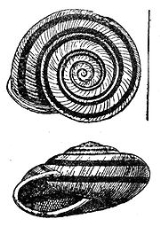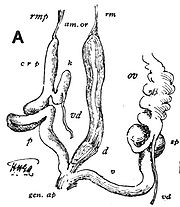
Ariophanta laevipes
Encyclopedia
Ariophanta laevipes is a species
of air-breathing land snail
, a terrestrial
pulmonate gastropod mollusk in the family Ariophantidae
.
Ariophanta laevipes is the type species
of the genus Ariophanta
.
of this species is left-handed (sinistral).
The shell is depressed, rather thin, obliquely striated and decussated with fine spiral lines above, smooth beneath. The shell color is white or whitish
with three spiral chestnut bands. The spire
is low and conoidal, with 5 slightly convex whorls
. The body whorl
is rounded beneath but angulate at the periphery, the angulation generally disappearing near the mouth.
The aperture is lunate and diagonal. The peristome
is in one plane, simple above, slightly thickened and reflected below.
The width of the shell is 23-28 mm. The height is 15 mm. There is a large flat variety.
The commonest variety is white with three spiral bands one near the suture, one above and one beneath the periphery. But some shells have the ground-colour brownish with darker bands, and some are white or dark brown throughout. The
parietal wall of the aperture and the area around the umbilicus are never darker than the adjacent portion of the last whorl.
 The reproductive system of Ariophanta laevipes includes a love dart
The reproductive system of Ariophanta laevipes includes a love dart
.
The teeth on the radula
have the formula 120 . 2 . 8 . 1 . 8 . 2 . 120 (130 . 1 . 130). The rhachidian tooth is tricuspid. The eight inner laterals are bicuspid and broad, forming a narrower median line than in other species of the genus, i.e. 17 teeth to 45 in the latter. The admedian teeth are bicuspid up to the 104th.
. In Bombay it is common in gardens. It also occurs in the Ilajpipla Hills, east of Surat
.
Species
In biology, a species is one of the basic units of biological classification and a taxonomic rank. A species is often defined as a group of organisms capable of interbreeding and producing fertile offspring. While in many cases this definition is adequate, more precise or differing measures are...
of air-breathing land snail
Snail
Snail is a common name applied to most of the members of the molluscan class Gastropoda that have coiled shells in the adult stage. When the word is used in its most general sense, it includes sea snails, land snails and freshwater snails. The word snail without any qualifier is however more often...
, a terrestrial
Terrestrial animal
Terrestrial animals are animals that live predominantly or entirely on land , as compared with aquatic animals, which live predominantly or entirely in the water , or amphibians, which rely on a combination of aquatic and terrestrial habitats...
pulmonate gastropod mollusk in the family Ariophantidae
Ariophantidae
Ariophantidae is a taxonomic family of air-breathing land snails and semi-slugs, terrestrial pulmonate gastropod mollusks in the superfamily Helicarionoidea .- Distribution :...
.
Ariophanta laevipes is the type species
Type species
In biological nomenclature, a type species is both a concept and a practical system which is used in the classification and nomenclature of animals and plants. The value of a "type species" lies in the fact that it makes clear what is meant by a particular genus name. A type species is the species...
of the genus Ariophanta
Ariophanta
Ariophanta is a genus of air-breathing land snails, terrestrial pulmonate gastropod mollusks in the family Ariophantidae. The shell is sinistral or left-handed in its coiling.This is a monotypic genus.- Species :...
.
Shell description
The shellGastropod shell
The gastropod shell is a shell which is part of the body of a gastropod or snail, one kind of mollusc. The gastropod shell is an external skeleton or exoskeleton, which serves not only for muscle attachment, but also for protection from predators and from mechanical damage...
of this species is left-handed (sinistral).
The shell is depressed, rather thin, obliquely striated and decussated with fine spiral lines above, smooth beneath. The shell color is white or whitish
with three spiral chestnut bands. The spire
Spire (mollusc)
A spire is a descriptive term for part of the coiled shell of mollusks. The word is a convenient aid in describing shells, but it does not refer to a very precise part of shell anatomy: the spire consists of all of the whorls except for the body whorl...
is low and conoidal, with 5 slightly convex whorls
Whorl (mollusc)
A whorl is a single, complete 360° revolution or turn in the spiral growth of a mollusc shell. A spiral configuration of the shell is found in of numerous gastropods, but it is also found in shelled cephalopods including Nautilus, Spirula and the large extinct subclass of cephalopods known as the...
. The body whorl
Body whorl
Body whorl is part of the morphology of a coiled gastropod mollusk.- In gastropods :In gastropods, the body whorl, or last whorl, is the most recently-formed and largest whorl of a spiral or helical shell, terminating in the aperture...
is rounded beneath but angulate at the periphery, the angulation generally disappearing near the mouth.
The aperture is lunate and diagonal. The peristome
Peristome
The word peristome is derived from the Greek peri, meaning 'around' or 'about', and stoma, 'mouth'. It is a term used to describe various anatomical features that surround an opening to an organ or structure. The term is used in plants and invertebrate animals, such as in describing the shells of...
is in one plane, simple above, slightly thickened and reflected below.
The width of the shell is 23-28 mm. The height is 15 mm. There is a large flat variety.
The commonest variety is white with three spiral bands one near the suture, one above and one beneath the periphery. But some shells have the ground-colour brownish with darker bands, and some are white or dark brown throughout. The
parietal wall of the aperture and the area around the umbilicus are never darker than the adjacent portion of the last whorl.
Anatomy

Love dart
A love dart is a hard, long, sharp, calcareous or chitinous dart which some hermaphroditic land snails and slugs create. Love darts are made in sexually mature animals only, and are used as part of the sequence of events during courtship, before actual mating takes place...
.
The teeth on the radula
Radula
The radula is an anatomical structure that is used by molluscs for feeding, sometimes compared rather inaccurately to a tongue. It is a minutely toothed, chitinous ribbon, which is typically used for scraping or cutting food before the food enters the esophagus...
have the formula 120 . 2 . 8 . 1 . 8 . 2 . 120 (130 . 1 . 130). The rhachidian tooth is tricuspid. The eight inner laterals are bicuspid and broad, forming a narrower median line than in other species of the genus, i.e. 17 teeth to 45 in the latter. The admedian teeth are bicuspid up to the 104th.
Distribution
This species lives in IndiaIndia
India , officially the Republic of India , is a country in South Asia. It is the seventh-largest country by geographical area, the second-most populous country with over 1.2 billion people, and the most populous democracy in the world...
. In Bombay it is common in gardens. It also occurs in the Ilajpipla Hills, east of Surat
Surat
Surat , also known as Suryapur, is the commercial capital city of the Indian state of Gujarat. Surat is India's Eighth most populous city and Ninth-most populous urban agglomeration. It is also administrative capital of Surat district and one of the fastest growing cities in India. The city proper...
.
Life cycle
The egg of Ariophanta laevipes is elliptical, longitudinally sulcated, enclosed in a tough membrane, and 4 to 5 mm in length, 4-4.5 in diameter.External links
- image of radula of Ariophanta laevipes
- http://www.worldwideconchology.com/Ariophantidae.htm with link to an image of Ariophanta laevipes

